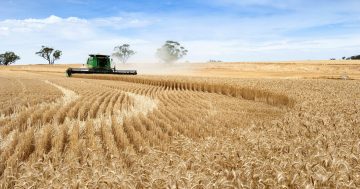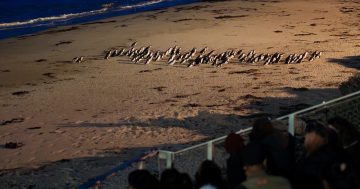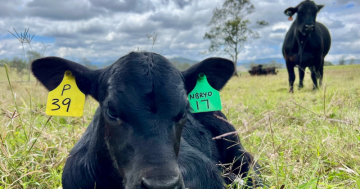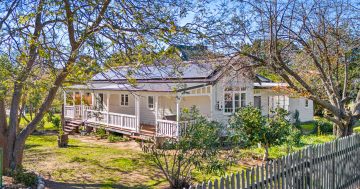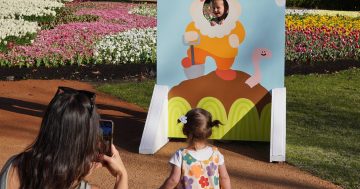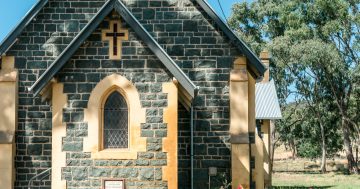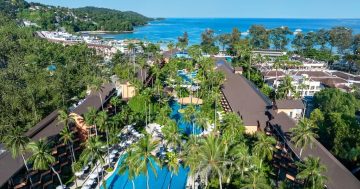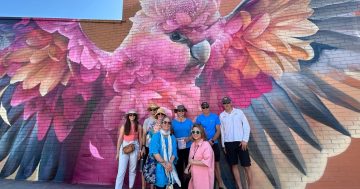By John Rozentals.
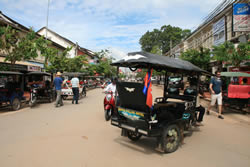
Go on, take a chance … a tuk-tuk in downtown Siem Reap.
Siem Reap is a bustling, mid-sized city of about 150,000 in north-western Cambodia, not far from the northern edge of Tonlé Sap, an enormous lake which very nearly punctuates the flow of the mighty Mekong River on its flow to the South China Sea.
It’s nothing out of the Asian ordinary — though compared to Australia anything there is quite extraordinary — and would hardly rate a place on the itinerary of many if it wasn’t gateway to the marvellous temples of Angkor Wat and surrounds, and largely, I guess, as the subsequent terminal for many Mekong cruises ex Vietnam.
But it is a vibrant city well worth spending a bit of time exploring in between incredible temples, just for its food culture and the studio of an amazing artist.
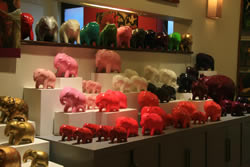
Spend a few coins in a good cause … classy lacquerware on sale in Theam’s House.
The artist is Lim Muy Theam, who was just nine when he fled the country’s dreaded Khmer Rouge madness and became a refugee — and studied art — in Paris.
He has since returned to Cambodia and set up his own studio in Siem Reap to promote the country’s reknowned painting, sculpting and lacquerware — and to launch an art project promoting these skills among its many unemployed young people.
The result is Theam’s House, which contains a labyrinth of studios and sales spaces devoted to this project and to the continued pursuit of his own distinctive painting.
Visit, while away a few hours, and spend some coin in a very good cause. You’ll get extreme value-for-money and you’ll be helping very much a group of people striving to help themselves.
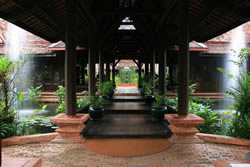
A distinguished entrance … the lobby at Siem Reap’s Angkor Village Resort.
Shortly after I visited Siem Reap — and other South-East Asian destinations — I was asked about the safety of eating there: “Just how fresh is the food?”
Generally very fresh! In a land of reasonably high temperatures and largely lacking our accepted standards of refrigeration and storage, food has to be fresh to be served.
While in Cambodia, I saw a great example of this in a young pig, presumably on the way to market. It was tied to the rear of a scooter and still squealing. How fresh to you want?
Do take a bit of care, though. I always tell people to avoid uncooked food, particularly items such as salads that could have been rinsed in water. Remember, water-borne diseases are the real enemy.
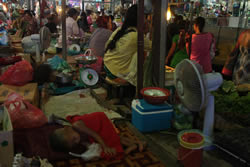
Phsar Chas … time to nod off.
And follow the lead of locals. They have to repeat the exercise daily and they’re unlikely be eating stuff that’s suspect. More than likely they’ve found a source of sound, tasty tucker.
Locals and tourists alike seem to make a beeline after dark to the Angkor Night Market, which is held daily near the centre of town.
It features an interesting array of food stalls as well as a range of general stalls. Remember, though, that it’s always a case of buyer beware. There doesn’t seem to be any redress system.
To get a taste of where the real locals eat and shop, head to Phsar Chas, Siem Reap’s old market, open daily from 8am to 6pm between Pub Street and the riverside.
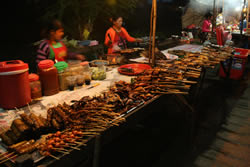
Angkor Night Market … an interesting array of food stalls.
It’s an obvious hot spot where you’ll find fine street food and a range of delicious produce, including quite exotic fruit and vegetables.
You’ll find yourself rubbing shoulders with expats as well as genuine Cambodians, and believe me I do mean rubbing shoulders. It can get really crowded.
And do treat with disdain any suggestion that eating grasshoppers and cicadas is a cuisine of choice.
During the ‘Killing Fields’ days of the late 1970s, when the Khmer Rouge executed perhaps a couple of million folk and brought the country virtually to its knees, bugs were all that was left for many to survive on and they became a cuisine of necessity — one that seems to have survived.
Accommodation-wise the proximity of Angkor Wat seems to have guaranteed plenty of choice.
I can personally recommend the plush Angkor Village Resort.
The rooms are impeccable, the food and service first-class, the 250-metre room-side lap pool an absolute treat.
Oh, and lay your life on the line. Get around the city by tuk-tuk … the local version of a cab.
Images: Sandra Burn White.
IF YOU GO
Theam’s House: No 25, Veal Village, Kokchak Commune, Siem Reap; visit www.theamshouse.com.
Angkor Night Market: Steung Thmai Village, Sangkat Svay Dangkum, Siem Reap; visit www.angkornightmarket.com.
Phsar Chas: between Pub Street and the riverside, Siem Reap.
The Angkor Village Resort: Phum Traeng, Siem Reap; visit www.angkorvillageresort.asia.
Cambodian tourism: for general information, visit www.tourismcambodia.com.


